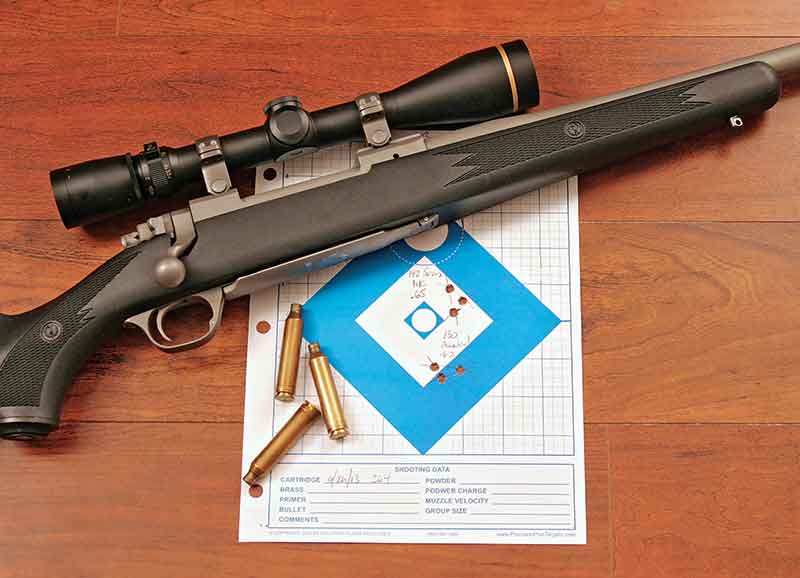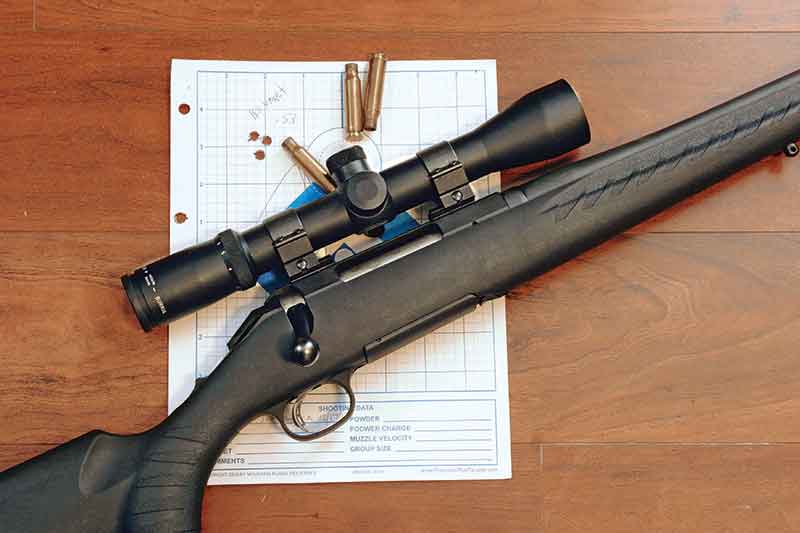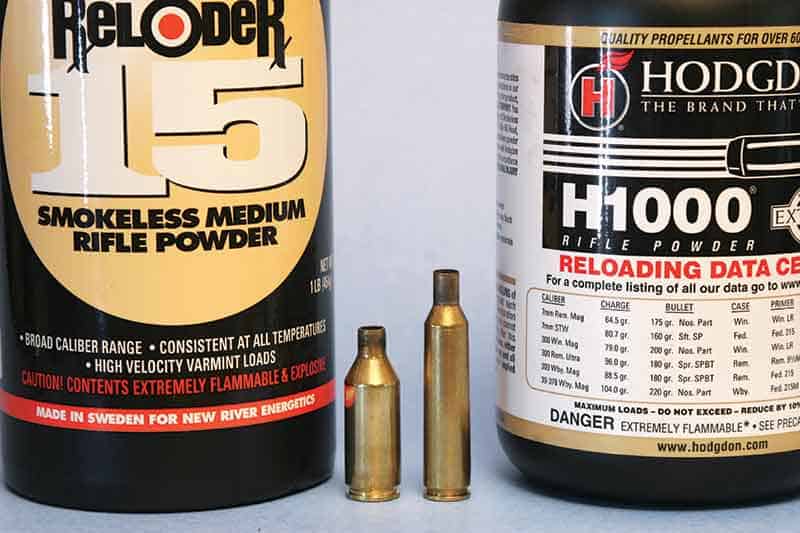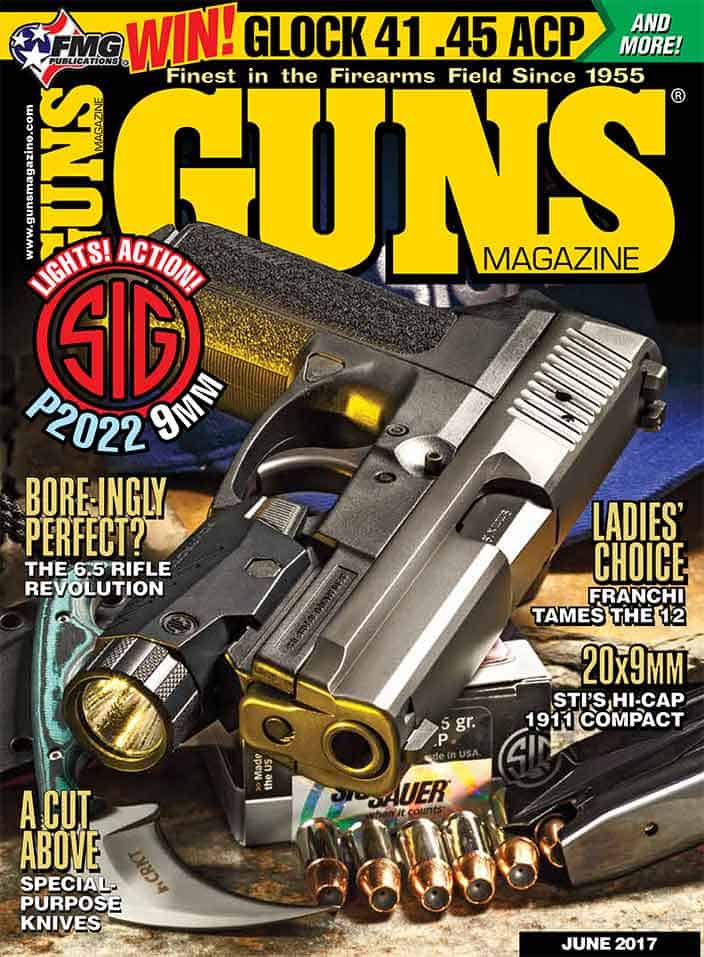Rifle Cartridge Roulette
Some Win, Some Lose. How Do You Know What
Will Stay? Here Are Some Clues.
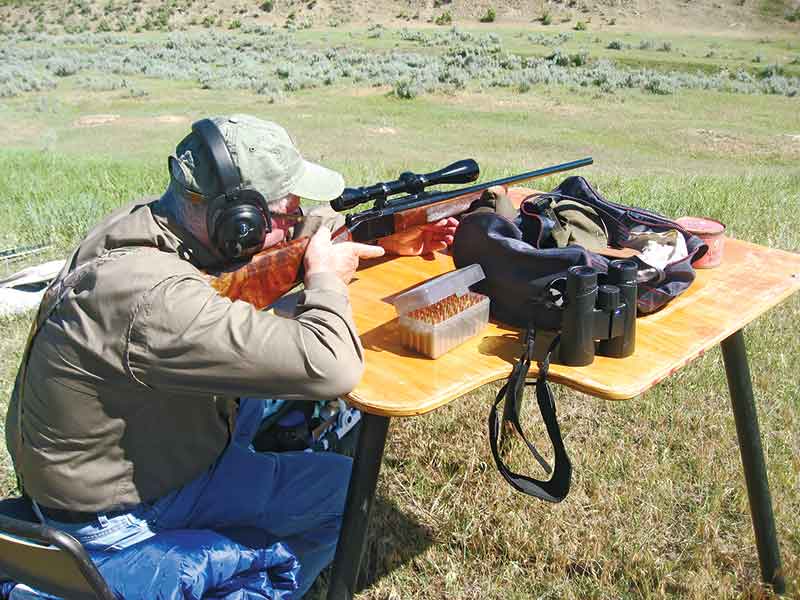
One recent trend is faster rifling twists for longer bullets with high ballistic coefficients, and many hunters would like
to buy fast-twist .22-250’s for deer hunting. But many traditional shooters still use .22-250’s such as this Colt
Sharps-Borchardt single-shot for prairie dog shooting, and fast twists in hot barrels can cause problems with
thin-jacketed varmint bullets.
Why do some new rifle cartridges immediately start selling like cheeseburgers, while others become the shooting equivalent of liver and onions? While some people like liver and onions, most don’t eat ’em more than once a month, and they’re not listed on many restaurant menus.
Ammunition and rifle companies would certainly like to know the answer, since it costs far more to introduce a new smokeless-powder rifle round than trendy “Tuscan” sandwiches. And new rounds must compete with many existing rounds since, unlike food fads, rifle cartridges aren’t chewed up and digested.
Dozens of smokeless rounds introduced over a century ago are still chambered in new factory rifles, and the .30-30 Winchester, .30-06 Springfield continue to sell like cheeseburgers. Several others sell like fancied-up (Tuscan?) cheeseburgers, including the 6.5×55, 7×64 and 7x65R Brenneke, .303 British, .35 Remington, 8×57 Mauser, 9.3×62 Mauser, .375 H&H, .416 Rigby and .470 Nitro-Express. (The last two aren’t common, but still rate among the most popular chamberings for BIG game.)
Some more recent cartridges also became cheeseburgers, including several chambered in almost every bolt-action factory rifle—the .223 Remington, .243 Winchester, .308 Winchester, 7mm Remington Magnum and .300 Winchester Magnum. Many companies also chamber what might be called Adjunct Cheeseburgers, including the .22 Hornet, .204 Ruger, .25-06 Remington, 6.5 Creedmoor, .300 WSM and .338 Winchester Magnum.
With all those cartridges chambered in new factory rifles, why do companies keep introducing new cartridges? Well, the primary reason is to make money. This sounds obvious and cynical, but rifles aren’t pickup trucks or dishwashers. Instead of wearing out in a decade or two, they often last several lifetimes. My own modest collection includes rifles from the late 1800’s, all with original barrels, the most frequently replaced part.
If it weren’t for new cartridges, most shooters would continue using rifles chambered for cheeseburgers like the .223 Remington and .30-06—and many do. But a friend in the firearms industry claims the profit margin in sporting rifle manufacturing comes from what he calls “churners”—the shooters who continually search for the rifle/cartridge combination sure to change their lives.
What I’ve noticed during a half-century of churning is the majority of successful “new” cartridges fill an already existing demand. The classic example is the .22 Hornet, apparently the only cartridge produced by a major ammunition factory before any factory .22 Hornet rifles appeared.
The Hornet originated as a wildcat in the late 1920’s, the final touches occurring at the US military’s Springfield Armory, where part-time gun writer Colonel Townsend Whelen was director of research and development. The Hornet was then the flattest-shooting “varmint” round, so it filled a definite niche, and with Whelen’s publicity it couldn’t fail—and still hasn’t—because new powders and bullets boost its original ballistics.
The 7mm Remington Magnum is another example of pent-up demand. Several other 7mm magnums already existed, including the 7mm Weatherby, but none had the backing of a major American company. Remington’s “Big Seven” became a cheeseburger almost instantly in 1962, soon after appearing in their also-new Model 700 rifle
Misfire
Winchester had a chance to fill the 7mm demand in 1959, but instead introduced the .264 Winchester Magnum, using 6.5mm bullets, then considered metric oddballs by American hunters. The .264 still sold OK—but only until the 7mm Remington appeared, the cartridge everybody really wanted.
Apparently Winchester learned their lesson. While 1963’s .300 Winchester Magnum was far from the first commercial .30 caliber magnum, it was the first .300 designed by a major American company. Between pent-up demand and availability of “affordable” rifles and ammunition, both Remington’s 7mm and Winchester’s .300 became world standards.

These days, shorter cartridges are a major trend, but they can be too short. The Winchester Super-Short Magnums, like
the .223 WSSM (left), were so short and fat they required new bolt actions. Other shorter cartridges (2nd left to right),
such as the 6.5 Creedmoor, 6.5/.284, .300 WSM and .375 Ruger, were designed to fit existing actions.
Dud
But the Remington and Winchester names couldn’t help several other cartridges appearing during the same era. The .256 Winchester Magnum appeared in 1960, chambered in a Marlin lever-action rifle and Ruger single-shot handgun. It was promoted as an improvement of the old .25-20 WCF, but apparently very few shooters wanted an “improved” .25-20. Why would they? Far better varmint rounds already existed, including the .22 Hornet, which almost killed off the .25-20 a generation earlier. Plus, the extra velocity of the .256 ruined too much meat on small game, yet didn’t make it a big game cartridge. But somebody at Winchester thought the .256 would brighten shooters’ lives.
The 6.5 Remington Magnum appeared in 1966, another attempt to force 6.5’s on the American shooter. Somebody at Remington believed American hunters yearned for a light bolt-action rifle that would serve both for woods and open-country hunting, so designed a strange-looking carbine called the Model 600. But most deer hunters of the day preferred either traditional rifles, whether lever-actions chambered for moderate-velocity rounds or longer-barreled bolt actions in high-velocity rounds. They didn’t want a bolt-action carbine that, at woods ranges, ruined as much meat as a .270 Winchester, and at longer ranges didn’t work any better than a .270—or a 7mm Remington Magnum.
Hangfire To Prairie Fire
One general rule of magnum-cartridge introduction is to make a new magnum at least as fast as existing magnums, not slower—though unforeseen changes can overrule that rule, or any rule. Fifty years later cartridges similar to the 6.5 Remington are becoming more popular. None have belted cases—belt-free became the law of the land around 2000 A.D.—but short 6.5mm rounds are the hot new item, even in relatively short-barreled, light rifles, because of boattailed bullets with high ballistic coefficients. These soon catch up to typical spitzers, not only resulting in more down-range velocity but noticeably less wind drift.
While average hunters still believe higher muzzle velocity is the solution to longer-range shooting, the modest 6.5 Creedmoor provides better performance than standard .270 Winchester ammunition at any range from about 300 yards out, yet closer-range performance is also fine, with 2/3 the recoil. The Creedmoor is yet another example the result of pent-up demand—from target shooters, though the demand soon spread to hunters.
Several short 6.5mm cartridges already existed, but the Creedmoor was the first offered in inexpensive, yet accurate, rifles and factory ammo. Like a few other short, mild rounds it’s often used by women hunters, the fastest-growing demographic in shooting. Several of my Montana buddies have purchased Creedmoors for their wives, when a few years ago the usual choice was a .243 Winchester or 7mm-08 Remington.
The success of the 6.5 Creedmoor was caused by changes in both ammunition components and rifle actions, and both have affected other rounds. The .300 H&H was originally designed to match .30-06 ballistics with British Cordite, a spaghetti-stranded propellant even more heat-sensitive than most other early smokeless powders. Like its “parent” .375 H&H case, the .300 case was pretty long, so it would hold enough Cordite, and tapered so sticky cases could be easily extracted in tropical heat. The tapered case required a belt for sure headspacing, and the length a longer magazine than the .30-06.
The .300 H&H didn’t turn into a “magnum” until it became popular in the US, where better powders resulted in more velocity, especially 1940’s IMR4350.
Eventually, however, long magazines became unpopular, partly due to the flood of cheap “war surplus” 98 Mausers and 1903 Springfields after World War II—one reason shorter belted magnums started appearing, including the 7mm Remington and .300 Winchester Magnums. Both the Remington 700 and Winchester Model 70 could accommodate the .300 H&H, but new magnums able to fit in Mausers and Springfields widened the market. In fact many early .300 Winchester Magnums were rechambered 1903 Springfields.
Even shorter bolt-actions soon became more popular, partly because hunters want lighter rifles, but also because many became convinced shorter, stiffer actions are more accurate. This is true, the reason most target shooters use short actions, but finding any meaningful difference in a hunting rifle would be difficult. Still, perception is part of marketing, and many hunters are convinced they need a short-action rifle chambered for, say, the 6.5 Creedmoor to slay deer at 300 yards.
Today’s rifle powders also played a role, since they’re able to produce more velocity in smaller cases than older powders, whether Cordite or IMR4350. Thus we have shorter cartridges able to produce high velocities, and many hunters are still convinced muzzle velocity is the true measure of any hunting cartridge—the reason Remington’s Short Action Ultra Magnums lost out to Winchester’s Short Magnums.
But the WSM’s were also closer in design to several wildcat and “proprietary” short, fat, beltless magnums, so profited from pent-up demand. However, the Remington’s SAUM’s are making a comeback as the basis for some hot new 6.5mm cartridges, because they’re shorter than the WSM’s.
Ruger’s introduction of their .300 and .338 Compact Magnums a few years later is another interesting example. The .300 RCM didn’t even provide the muzzle velocity of the .300 SAUM, but did appear in a light, handy short-barreled rifle. However, the nifty 20-inch barreled Ruger Hawkeyes didn’t convince most hunters to abandon the WSM’s—but the RCM case is also being used for new 6.5’s, again because it’s shorter.
The failure of the Winchester Super Short Magnums is an example of another mechanical limit: They’re so short and fat, brand-new Browning and Winchester bolt-actions had to be designed to handle them—but also prevented rifle loonies from rebarreling conventional actions to the new rounds.
Plus, neither the .243 or .25 WSSM’s produced more velocity than already existing cartridges, including several non-magnums. The .223 WSSM did, probably why it became the most popular of the three, though not anywhere near a Tuscan cheeseburger.
Another mechanical problem is rifling twist. Due to longer high-BC and “monolithic” bullets the 21st-century trend is toward faster twists, but they can cause problems in older cartridges. Some modern hunters would love to be able to buy a factory .22-250 with a 1:8-inch twist, in order to use longer bullets, but most hunters still think of the .22-250 as a light-bullet, high-velocity varmint round. During prairie dog shooting, .22-250 barrels can get hot due to repeated shooting in summer temperatures, and a really hot barrel can do funny things to thin-jacketed bullets.
Strange Tales
On a PD shoot hosted by a rifle company several years ago to publicize a new .22-250, a major ammunition manufacturer supplied a new load with a thin-jacketed 45-grain bullet at very high velocity. It worked fine until barrels heated up, whereupon the bullets started zipping off in odd directions.
We ended up shooting one of the rifles on an improvised paper target out in the field, because it wouldn’t hit prairie dogs anymore. The barrel cooled while we put up the target, and the first couple rounds hit where they were supposed to, but the next few landed several inches from point of aim, with swirls of melted lead around the holes. That was with a conventional 1:14 twist. With a 1:8 twist, some bullets would have come apart in the air, something I’ve seen more than once with fast-twist barrels on prairie dog shoots.
We also had a couple of .223 Remingtons with standard 1:12 twists, using the same brand of ammo with the same bullet. Both shot fine even when really hot, and I have yet to see even a 1:8 twist .223 have any bullet problems on prairie dog towns. In fact they’re more effective, because the fast twist promotes bullet expansion. But the hot-barrel problem may be why we won’t be seeing many fast-twist .22-250’s.
It may also be why Winchester put a 1:10 twist in .223 WSSM rifles, a compromise between the 1:14 .22-250 twist and the fast twists used in wildcats like the .22/6mm Remington, AKA .224 Texas Trophy Hunter. The .223 WSSM has just about exactly the same powder capacity as the .22/6mm, so produces the same velocities, but while Winchester marketed the WSSM as a combination deer and long-range varmint round, the twist didn’t work for longer big game bullets. (My own .223 WSSM, a rebarreled Model 70, has a fast-twist barrel, but I don’t use it—or a .22-250—for prairie dog shooting.)
Military = Success
Of course, turning a military cartridge into a commercial hunting round has long been successful, but in recent decades its mostly worked for “American” rounds, especially the 5.56 NATO/.223 Remington and 7.62 NATO/.308 Winchester. I’ve hunted in Europe a few times, and during several days of red deer hunting in Norway ended up accompanying a couple dozen Norwegian hunters. None carried a 6.5×55. Instead the dominant round was the .308 Winchester, not only in the field but several sporting goods stores.
So what are the rules of hunting cartridge success? Mechanical and ballistic requirements keep changing, so it pays to keep up with the times. Fifty years ago rifles in 6.5mm cartridges were hard to sell, and short-action rounds were often considered “woods” cartridges. But today 6.5’s are the hottest trend, with short 6.5’s favored by many long-range hunters, and while the .264 Winchester has made a minor comeback, long-term success is limited by its unstylish belt.
But the most consistent rule is not to invent cartridges without a hint of previous demand. There’s no evidence the majority of traditional “woods hunters” who prefer tube-magazine lever actions desire any other cartridge than the .30-30 Winchester or .35 Remington, perhaps because if they want a little more zip from a lever rifle there are plenty of used Savage 99’s in .300 Savage. But cartridge designers keep trying to reinvent the cheeseburger. And cheeseburgers are good.

